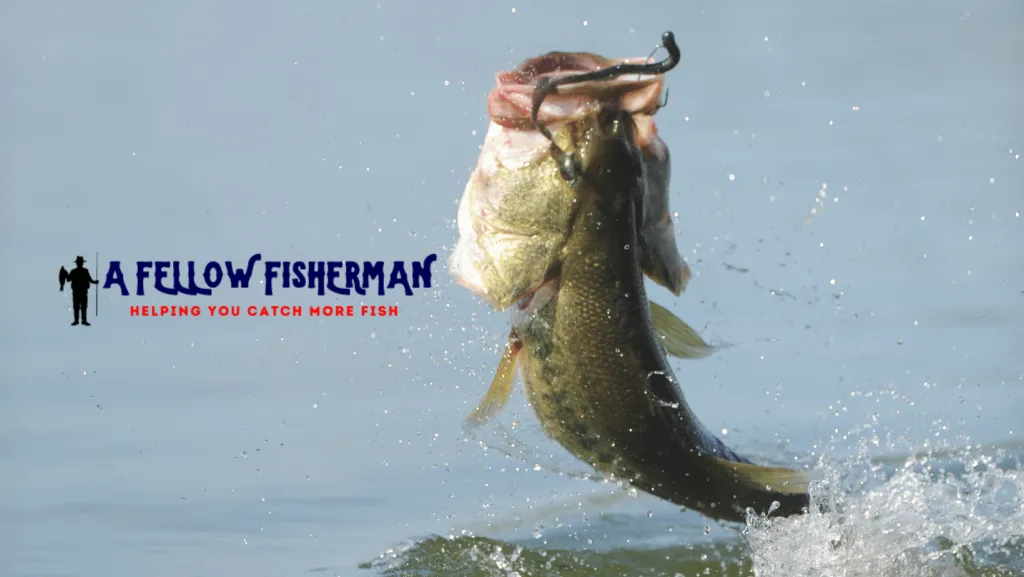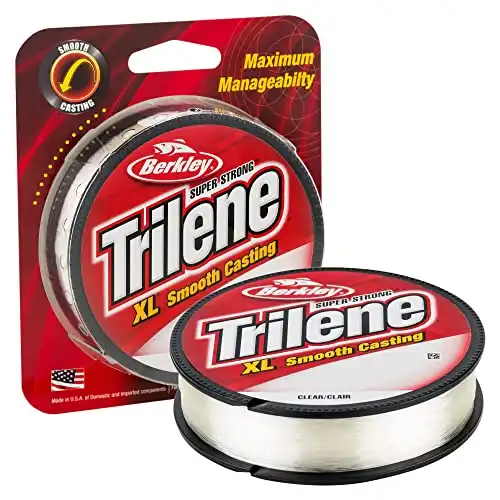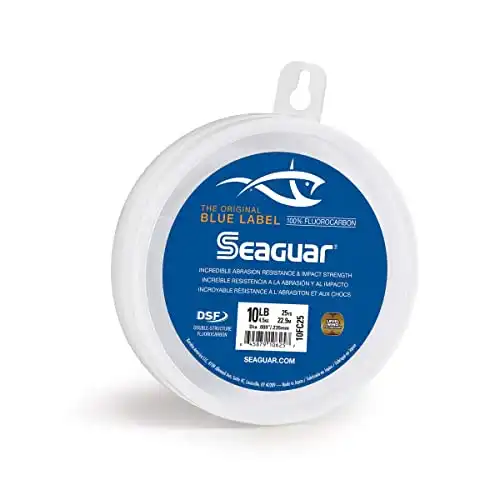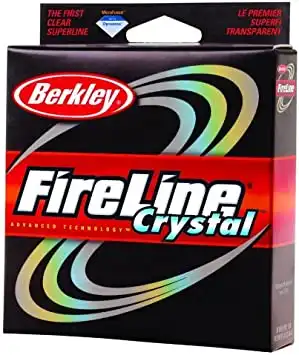
Bass anglers, have you ever been in a situation where you can’t seem to decide what pound test line is the best for bass fishing?
Well, have no fear, A Fellow Fisherman is here to help. We know that choosing the right pound test line can be difficult, so we’ve compiled a list of the best lines for bass fishing based on your needs.
Whether you’re looking for a line that’s strong enough to handle big fish or one that’s sensitive enough to feel every nibble, we’ve got you covered.
Types of lines for bass fishing
When it comes to bass fishing, line choice can be the difference between success and failure. There are three different types of lines for bass fishing, and each has its advantages and disadvantages. The most common type of line for bass fishing is monofilament line. We provide more info on these three bass fishing line types below.
Monofilament Fishing Line
The Trilene XL is an especially thin monofilament line that makes long casts smooth and easy to attain.
Monofilament fishing line is a type of fishing line made from a single strand of material. The most common monofilament fishing line is made from nylon, although other materials such as polyethylene and fluorocarbon make up the DNA of mono.
Monofilament fishing line has many advantages over different types of fishing line, including its high strength, low stretch, and low visibility in the water. Monofilament fishing line is also very inexpensive and easy to find, making it popular among anglers. However, monofilament fishing line can become weakened by sunlight and heat, so it should be stored in a cool, dark place when not in use.
Fluorocarbon Fishing Line
The line is created by combining two resins that combine into a dual structured fluorocarbon. That means it’s got great strength, high abrasion resistance, low visibility and will sink your bait fast.
Fluorocarbon fishing line is made from a fluoropolymer, a synthetic material known for its strength and durability. Fluorocarbon line is typically used for leaders. Fluorocarbon line is also prized for its invisibility underwater, making it ideal for easily spooked fishes.
In addition, fluorocarbon fishing line has a higher density than other types of fishing line, which helps them sink more quickly and provides better contact with the bottom. Fluorocarbon fishing line is the right choice for anglers looking for a durable and robust leader line.
Braided Fishing Line
Innovation is the reason FireLine Crystal is the most highly rated braided line in consumer reviews. FireLine is the first translucent braided line on the market.
A braided fishing line is beloved among anglers for its strength and durability. While made from multiple strands of synthetic fiber, a braided line can withstand high tension levels without breaking. Additionally, braided line is less likely to fray or kink than other types of fishing line. However, the braided line can be more challenging to control than different bass fishing lines, and it can also be more visible in the water. As a result, anglers must choose the right type of braided line for their needs. A braided fishing line can be an excellent choice for anglers looking for a durable and strong line.
What Pound Test For Bass Fishing
So, what pound test for bass fishing? The answer depends on your needs and preferences. No matter what type of line you choose, practice proper knot tying techniques to ensure a strong connection between your lure and line. You’re guaranteed to catch more bass this season with the right line!
Things to Consider
Certain factors such as weather conditions and the location of where you are fishing should consider when choosing which gear to fish with.
Weather Conditions
Wind, weather fronts, and barometric pressure will all affect the type of line that will yield the best results. The monofilament fishing line is generally less affected by weather conditions than the braided or fluorocarbon line.
Location of Fishing
You will also want to consider the water clarity and depth when choosing your line type. In murky or deep water, a braided line may be more visible to the fish and less likely to tangle around objects on the bottom. A fluorocarbon line will be less visible in deep water but may not be as strong as a monofilament line.
There is no “one size fits all” answer when it comes to choosing the best line for bass. However, by considering the factors listed above, you can decide which type of line is best for your needs.
Spinning reels vs. casting reels
To get the most out of bass fishing, you need a rod and reel right for your bass fishing technique. There is no one-size-fits-all for this specific sport, so find what works best by feel!
A spinning reel is an excellent option for those who want to use finesse bait and is best suited for lighter lines, such as drop shots and wacky rigs with small hooks. Twelve pounds of mono or fluoro weight will be perfect if you’re bass fishing; anything heavier isn’t necessary.
Baitcasting reels can cast heavy baits and provide an excellent balance between casting distance, weight capacity, and affordability. Most bass anglers outfit their baitcasters with 15-25 pounds test mono/fluoro or 30 – 65 pound braided line, which will avoid any spool binding issues when using thinner cords below this range on a standard spinning reel setup.
The narrow diameter allows for easy turnover while still providing enough drag power needed by big gamefish.
FAQ
Does line color matter for bass?
As any fisherman knows, line color can be essential to success. Generally, line color does not matter for bass, as these fish are not particularly line-shy. However, there are some situations in which line color can make a difference. For example, a lighter-colored line in clear water may be more visible to bass and, therefore, more likely to spook them. On the other hand, a darker line may be more difficult for the bass to see in darker water. As a result, line color can be a factor worth considering when fishing for bass in different types of water.
What pound test line should I use for a Texas rig or a Carolina rig for bass fishing?
When fishing for bass with a Texas rig or Carolina rig, the best pound test is 15-20 pounds. This line is strong enough to handle the weight of the lure and fish, but not so heavy that it will impede your fishing. The 15-20 pound line is also less likely to snap when compared to lighter fishing lines. In addition, this fishing line is also less likely to tangle, making it easier for you to fish.
However, if you are using a bass fishing rig in deep water or around vegetation, you may need to use a heavier fishing line. A 20-25 pound fishing line may be necessary in these cases. Ultimately, the best pound test to use for bass fishing depends on your fishing conditions.
What pound test should I use for bass fishing a crankbait?
When choosing a fishing line for bass fishing with a crankbait, it is crucial to consider the size of the lure and the water conditions. Anglers should generally use a heavier line in clear water and a lighter line in stained or murky water. In terms of specific pound tests, a good rule of thumb is to use a 10-12 lb test for small crankbaits, a 14-16 lb test for medium crankbaits, and an 18-20 lb test for large crankbaits. However, the most important thing is to experiment and find what works best for you in given conditions.
What pound test should I use for bass fishing a spinner bait?
Most anglers agree that fish with a spinnerbait should do so with a line that has a breaking strength of 8 to 12 pounds. This amount of test will give you enough power to land most bass while still allowing the bait to operate appropriately. If you’re fishing for more prominent bass or using a heavier spinnerbait, however, you may need to increase the pound test of your fishing line.
What pound test should I use for bass fishing a jig?
How much fishing line you need depends on the size and weight of your lure and the type of fishing you’re doing. If you’re fishing for bass with a jig, you’ll need a line that’s strong enough to handle the fish but not so heavy that it ruins the action of your lure. It may seem obvious, but I’ll say it anyway, a good rule of thumb is to use a higher test line for larger bass fishing lures and a lighter line for smaller lures. For example, if you’re fishing with a 1/2 oz jig, you’ll probably want to use a 15-20 pound test line. But if you’re using a smaller 1/8 oz jig, you can get away with using a 10-12 pound test line.
What pound test should I use for bass fishing with live bait?
The fishing line you use for bass fishing should be strong enough to withstand the weight of the fish. The amount of weight the fishing line can handle is called the “pound test.” The higher the pound test, the stronger the fishing line. For bass fishing with live bait, you should use a fishing line with a pound test of 10-20. This setup will give you the strength to reel in your catch without breaking the line. When choosing a fishing line, always err on caution and select a higher pound test than you think you’ll need. That way, you can ensure your line won’t break when you’re reeling in that trophy bass.
What is the best way to store fishing lines?
The best way to store fishing lines is in a spool or storage container. In addition, you should always hold your fishing line in a cool, dry place. This practice will help keep the line in good condition and will help to prevent it from becoming tangled and developing fishing line memory.
Final Thoughts
A fishing line is an essential part of every angler’s arsenal, but the line you choose for your fishing adventure depends on your bass fishing technique and the conditions. We hope this post has helped explain some common mistakes people make when selecting a line for bass fishing and provide a few helpful tips that should help get your line game in check. Good luck out there!
For more bass fishing tips, check out the pages below:













